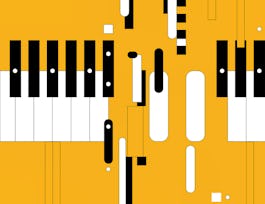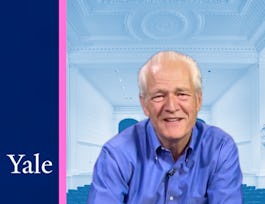Notre relation à Beethoven est profonde et paradoxale. Pour de nombreux musiciens, il représente une sorte de Saint-Graal : Sa musique est d'une intensité, d'une rigueur et d'une profondeur qui nous tiennent en haleine, et elle est peut-être inégalée en ce qui concerne les défis interprétatifs, techniques et même spirituels qu'elle pose aux interprètes. En même temps, la musique de Beethoven est familière à des millions de personnes qui n'assistent pas à des concerts ou qui ne se considèrent pas comme des musiciens. Deux cents ans après sa mort, il est omniprésent dans la culture, mais il en représente toujours le sommet. Ce cours aborde les 32 sonates pour piano du point de vue d'un interprète. Chaque cours se concentrera sur une sonate et sur un aspect de la musique de Beethoven qu'elle illustre. (Ces aspects peuvent inclure : la relation entre Beethoven le pianiste et Beethoven le compositeur ; le rôle critique que joue l'improvisation dans sa musique hautement structurée ; son mélange de musique extrêmement raffinée avec des éléments plus bruts ; et les façons souvent surprenantes dont les événements de sa vie ont influencé son processus de composition et le caractère de la musique qu'il était en train d'écrire) Le cours comportera une part d'analyse et de contexte historique, mais sa perspective est celle d'un musicien, et non d'un musicologue. Son objectif principal est d'explorer et de démystifier le travail de l'interprète, tout en embrassant l'éternel mystère de la musique de Beethoven elle-même.



(604 avis)
Détails à connaître
9 devoirs
Découvrez comment les employés des entreprises prestigieuses maîtrisent des compétences recherchées

Il y a 12 modules dans ce cours
Nous sommes heureux que vous nous ayez rejoints ! Les éléments que vous voyez ici vous permettront de tirer le meilleur parti de ce cours. Veuillez noter que de nombreux éléments ont été mis à jour pour refléter l'ajout des dernières conférences de Jonathan.
Inclus
4 lectures
Pour examiner la relation que Beethoven entretenait avec la sonate pour piano, nous commençons par nous pencher sur ses origines. Dans cette conférence, nous discuterons du rôle de la musique en général, et de la sonate en particulier, à l'époque de Haydn et de Mozart. Nous présenterons également la forme de la sonate et l'effet psychologique que la structure de la sonate a sur l'auditeur. Ce contexte sera nécessaire pour apprécier les innovations introduites par Beethoven.
Inclus
6 vidéos3 lectures1 devoir
L'œuvre de Beethoven est traditionnellement divisée en trois ou quatre périodes. Cela pose problème pour diverses raisons, mais les 13 premières des 32 sonates forment, en un sens, une unité. Cette conférence se concentrera sur la sonate n° 4, opus 7, qui est la plus grande et l'une des plus impressionnantes des œuvres de jeunesse. Les sujets abordés seront l'utilisation du piano par Beethoven et l'utilisation de la sonate comme "véhicule" pour le pianiste, les façons dont cette sonate et d'autres sonates de jeunesse se conforment au modèle établi par Haydn et Mozart et les façons dont elles ne s'y conforment pas, et la préfiguration des fixations des années ultérieures, tout en respectant, au moins en apparence, les conventions de l'époque. Les thèmes abordés seront l'utilisation du piano par Beethoven et l'utilisation de la sonate comme "véhicule" pour le pianiste, la manière dont cette sonate et d'autres sonates de jeunesse se conforment au modèle établi par Haydn et Mozart et la manière dont elles ne s'y conforment pas, ainsi que la préfiguration des fixations des années ultérieures, tout en respectant, au moins en apparence, les conventions de l'époque.
Inclus
4 vidéos3 lectures1 devoir
La conception de la sonate par Beethoven était en perpétuelle évolution, mais l'année 1801 est particulièrement expérimentale. Les quatre sonates opus 26 à 28 (nos 14 à 17, chronologiquement) présentent les innovations les plus concrètes parmi les sonates écrites jusqu'alors, et sont au centre de cette conférence. Nous discuterons de la relation entre les mouvements d'une sonate classique et du changement radical qu'elle commence à subir à ce moment-là. Nous examinerons également la manière dont ces sonates ont influencé les générations futures de compositeurs, ce qui n'a pas été le cas des œuvres antérieures, aussi grandes soient-elles. En guise de particularité pour cette conférence, un enregistrement du premier mouvement de l'opus 28 par un étudiant actuel de Curtis sera disponible sur Curtis Performs.
Inclus
5 vidéos4 lectures1 devoir
De 1793 à 1809, Beethoven compose à un rythme soutenu. Mais pendant les années qui suivent, il marque le pas de façon spectaculaire, car il doit faire face à l'apparition de sa surdité, à des circonstances personnelles très éprouvantes et à la lutte pour trouver ce qui deviendra son style tardif, qui implique, dans une mesure remarquable, la réinvention totale de son langage musical. Cette conférence examine l'intersection de ces trois questions, ainsi que sa vie et sa musique de manière plus générale. Les œuvres discutées proviennent de cette période relativement creuse et comprennent la Fantaisie, op. 77, qui illustre le rôle vital de l'improvisation dans toute la musique de Beethoven, ainsi que les Sonates op. 78 et 81a, le "Lebewohl" Cette dernière constitue l'une des seules expériences sérieuses de Beethoven en matière de musique à programme, ce qui en a fait un point de référence important pour de nombreux compositeurs du XIXe siècle. Un autre sujet sera la façon dont les œuvres de cette période semblent manipuler le temps, ce qui a toujours été l'une des principales fascinations de Beethoven et qui devient de plus en plus critique à l'approche de la période tardive
Inclus
5 vidéos4 lectures1 devoir
Cette conférence se concentrera sur la Sonate op. 109, la première des trois dernières, dans laquelle la lutte de Beethoven avec la forme, qui a duré des décennies, trouve une conclusion étonnante. Nous reviendrons également sur la première période - la Sonate Op. 10, No. 1 (la septième qu'il ait écrite) en particulier - afin de faire un "zoom arrière" et d'examiner l'évolution qui s'est produite entre-temps : une évolution non seulement de la forme, mais aussi du style, du langage musical, de la conception qu'avait Beethoven du rôle de la musique. Cette conférence comprendra également une discussion sur l'héritage de Beethoven, en particulier sur la manière dont sa musique en est venue à représenter à la fois la plus haute aspiration possible et le problème le plus insurmontable pour les générations de compositeurs qui l'ont suivi.
Inclus
4 vidéos3 lectures1 devoir
Cette conférence se penche sur deux des premières sonates : la sonate en fa mineur, opus 2, no 1 (la première des 32), et la sonate en fa majeur, opus 10, no 2. Contrairement à la conférence "The First Thirteen", qui portait nominalement sur la Sonate Op. 7 mais cherchait à aborder la période des débuts en général, cette conférence se concentre sur les caractéristiques spécifiques qui rendent chacune de ces œuvres unique ; l'une est principalement une pièce dramatique, tandis que l'autre est très comique. La conférence porte également sur la relation complexe de Beethoven avec le passé musical - comment il l'a utilisé comme source d'inspiration tout en essayant de le laisser derrière lui.
Inclus
13 vidéos2 lectures2 devoirs
Le sujet de cette conférence est la Sonate Op. 57, communément appelée "Appassionata", l'une des œuvres les plus emblématiques de Beethoven. La trajectoire émotionnelle inhabituelle (pour Beethoven) et implacable de la sonate est un sujet majeur, tout comme l'utilisation par Beethoven d'un accord surprenant comme une sorte d'"idée fixe", contribuant à unifier l'œuvre et à mettre en évidence son caractère extraordinaire. Un autre sujet essentiel est la manière dont l'"Appassionata" illustre l'ingéniosité inégalée de Beethoven - comment il peut utiliser le moindre matériau pour créer une vaste toile.
Inclus
7 vidéos2 lectures1 devoir
Cette conférence explore la Sonate Op. 101, généralement considérée comme la première sonate appartenant à la période tardive. Les principaux sujets abordés sont l'instabilité harmonique inhabituelle du premier mouvement et la manière dont elle devient une source de caractère pour la musique ; la manière dont la portée de la sonate s'élargit au fur et à mesure, ce qui aide à clarifier son statut d'œuvre de la période tardive, et la grande influence de la sonate sur les compositeurs ultérieurs, Schumann et Mendelssohn en particulier.
Inclus
8 vidéos2 lectures1 devoir
La bibliothèque d'apprentissage contient des ressources supplémentaires pour vous aider pendant et après ce cours : des notes de cours, des lectures suggérées et des liens vers des fichiers audio en streaming pour la plupart des sonates étudiées dans le cours.
Inclus
3 lectures
Faites-nous part de votre expérience en prenant quelques minutes pour répondre à une enquête de satisfaction.
Inclus
1 lecture
Consultez cette page pour connaître les nouveautés et les événements !
Inclus
6 lectures
Instructeur

Offert par
Recommandé si vous êtes intéressé(e) par Musique et art

California Institute of the Arts

Dartmouth College

Yale University

University of Michigan
Pour quelles raisons les étudiants sur Coursera nous choisissent-ils pour leur carrière ?




Avis des étudiants
604 avis
- 5 stars
86,58 %
- 4 stars
11,58 %
- 3 stars
1,65 %
- 2 stars
0 %
- 1 star
0,16 %
Affichage de 3 sur 604
Révisé le 9 avr. 2022
Excellent deep dive into several of Beethoven's most interesting Sonatas. Jonathan's playing is amazing, and his descriptions of the work are engaging.
Révisé le 30 avr. 2016
Going through it for the second time this summer. My all time favorite Coursera course, and I've done almost ten...
Révisé le 10 févr. 2018
This course and the other two with Johnathan Biss have greatly expanded my appreciation and understanding of Beethoven's sonatas

Ouvrez de nouvelles portes avec Coursera Plus
Accès illimité à 10,000+ cours de niveau international, projets pratiques et programmes de certification prêts à l'emploi - tous inclus dans votre abonnement.
Faites progresser votre carrière avec un diplôme en ligne
Obtenez un diplôme auprès d’universités de renommée mondiale - 100 % en ligne
Rejoignez plus de 3 400 entreprises mondiales qui ont choisi Coursera pour les affaires
Améliorez les compétences de vos employés pour exceller dans l’économie numérique
Foire Aux Questions
L'accès aux cours et aux devoirs dépend de votre type d'inscription. Si vous suivez un cours en mode audit, vous pourrez consulter gratuitement la plupart des supports de cours. Pour accéder aux devoirs notés et obtenir un certificat, vous devrez acheter l'expérience de certificat, pendant ou après votre audit. Si vous ne voyez pas l'option d'audit :
Il se peut que le cours ne propose pas d'option d'audit. Vous pouvez essayer un essai gratuit ou demander une aide financière.
Le cours peut proposer l'option "Cours complet, pas de certificat" à la place. Cette option vous permet de consulter tous les supports de cours, de soumettre les évaluations requises et d'obtenir une note finale. Cela signifie également que vous ne pourrez pas acheter un certificat d'expérience.

